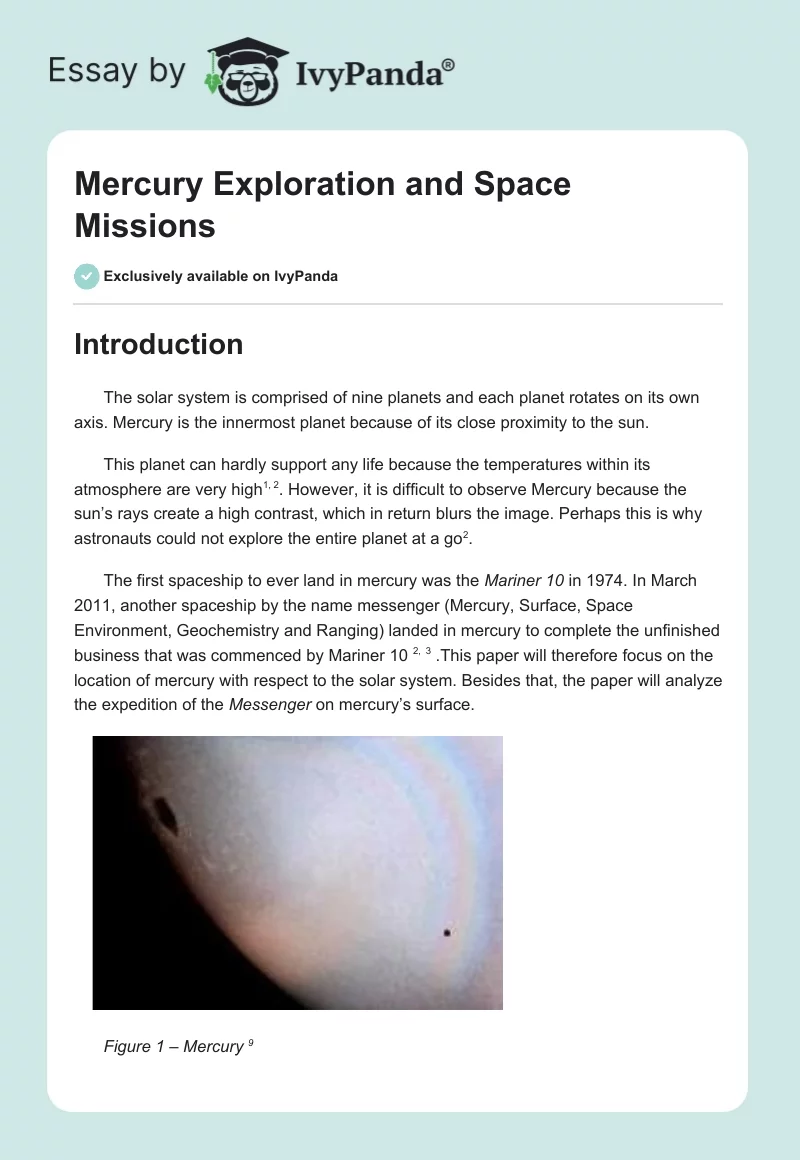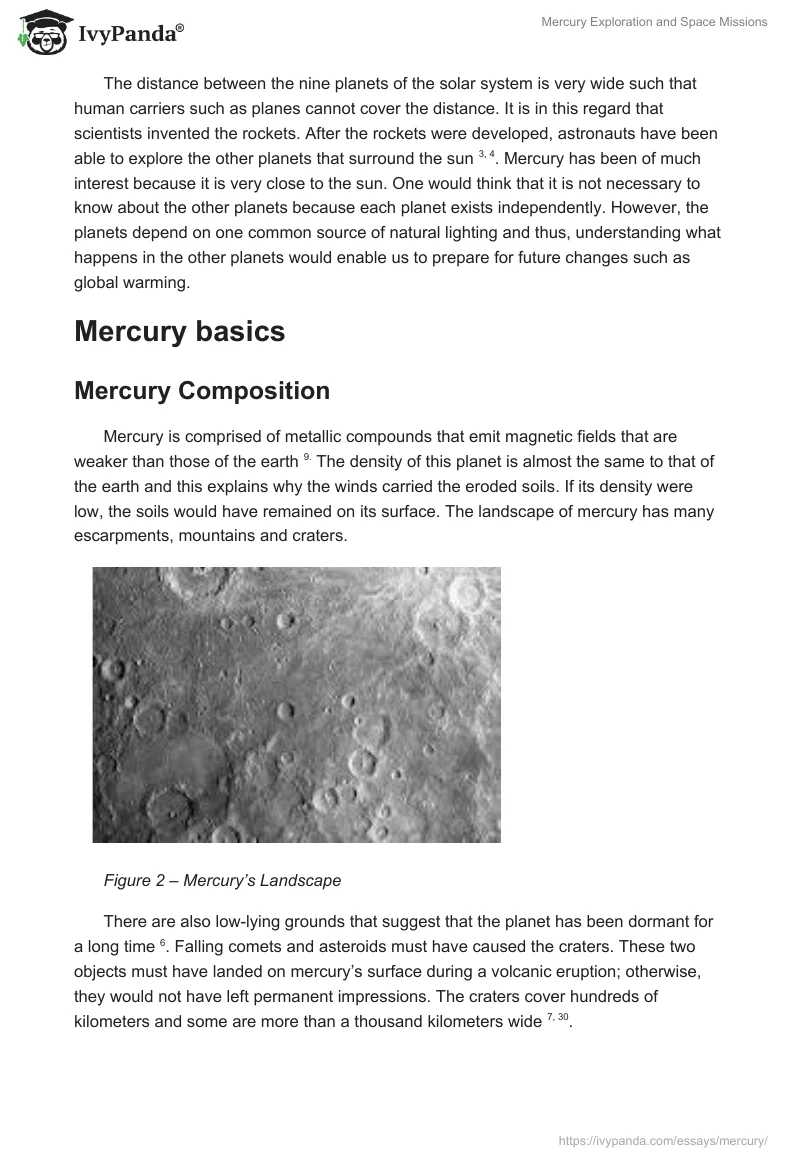Introduction
The solar system is comprised of nine planets and each planet rotates on its own axis. Mercury is the innermost planet because of its close proximity to the sun.
This planet can hardly support any life because the temperatures within its atmosphere are very high. However, it is difficult to observe Mercury because the sun’s rays create a high contrast, which in return blurs the image. Perhaps this is why astronauts could not explore the entire planet at a go.
The first spaceship to ever land in mercury was the Mariner 10 in 1974. In March 2011, another spaceship by the name messenger (Mercury, Surface, Space Environment, Geochemistry and Ranging) landed in mercury to complete the unfinished business that was commenced by Mariner 10. This paper will therefore focus on the location of mercury with respect to the solar system. Besides that, the paper will analyze the expedition of the Messenger on mercury’s surface.
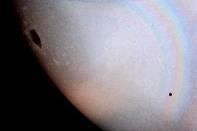
The distance between the nine planets of the solar system is very wide such that human carriers such as planes cannot cover the distance. It is in this regard that scientists invented the rockets. After the rockets were developed, astronauts have been able to explore the other planets that surround the sun. Mercury has been of much interest because it is very close to the sun. One would think that it is not necessary to know about the other planets because each planet exists independently. However, the planets depend on one common source of natural lighting and thus, understanding what happens in the other planets would enable us to prepare for future changes such as global warming.
Mercury basics
Mercury Composition
Mercury is comprised of metallic compounds that emit magnetic fields that are weaker than those of the earth. The density of this planet is almost the same to that of the earth and this explains why the winds carried the eroded soils. If its density were low, the soils would have remained on its surface. The landscape of mercury has many escarpments, mountains and craters.
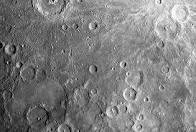
There are also low-lying grounds that suggest that the planet has been dormant for a long time. Falling comets and asteroids must have caused the craters. These two objects must have landed on mercury’s surface during a volcanic eruption; otherwise, they would not have left permanent impressions. The craters cover hundreds of kilometers and some are more than a thousand kilometers wide.
Just like the earth, mercury’s core is comprised of molten lava due to high temperatures. The falling comets pierced through its core, which caused the molten magma to leak into the pools that the falling objects created. Mercury is very small compared to the other planets.
One would thus expect it to go round the sun much faster than the other planets but contrary to this, its speed is relatively slow. It takes 59 days to complete one round. The earth takes 365 days, which adds up to one calendar year. This rotation is what brings the changes in seasons. For instance, during certain months days are longer than nights and vice versa. That is why darkness takes longer to set in.
The metallic components cause mercury most of the light it receives from the sun and that is why it can be confused with the moon. There is hardly any water or even water vapor for that matter on mercury’s atmosphere. This is because the high temperatures would evaporate the water. But amazingly there is frozen water beneath the craters and it seems the craters shield the ice water from the high temperatures because if this was not the case the ice would have been melted and eventually evaporate into the thin air.
Mercury does not have an atmosphere, but the exosphere, which has metallic compounds such as potassium, helium, hydrogen and sodium, occupies this vacuum. Besides that, the orbit of this planet hindered its possible exploration. Mercury has a higher orbit speed and thus the spaceship must travel at very fast speeds because any kind of hesitation would cause the entire house consumed.
The above statement may not sound logical because mercury is in close proximity with the sun and thus the rays of sun are still much stronger when they land on its surface. In fact, the temperatures in this planet can exceed 400 degrees Celsius during the day and subside to lows of negative one hundred and seventy. It is important to note that its not all craters in mercury that contain ice water and hence the ice limited to north and south poles which are at the extreme ends of the planet and thus they rarely come into contact with sun light.
It is possible to see mercury via a telescope. One can spot the planet on the western skies before the fall of darkness and early in the morning on the eastern skies. However, one cannot see the whole image because light does not shine on the entire planet. The planet appears in phases similar to those of the moon such as half and full.
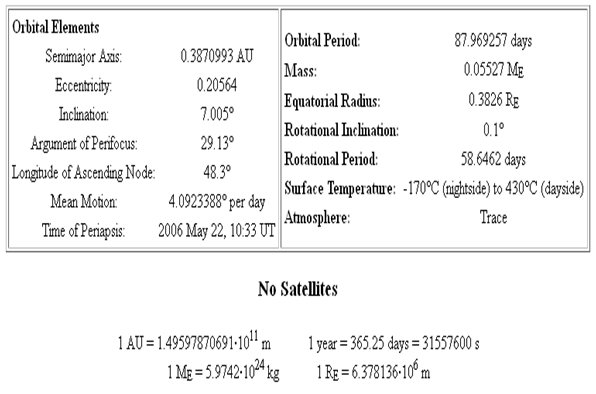
Mariner 10
Mariner 10 was the first spaceship that NASA (National Aeronautics and Space administration) deployed to mercury in 1974. This model aimed at eliciting an understanding of mercury’s environment, features and atmosphere. Among the tools fitted on the Mariner 10 included cameras with digital tape recorder, ultraviolet spectrometer, infrared radiometer, solar plasma, charged particles, magnetic fields, radio occultation and celestial mechanics.
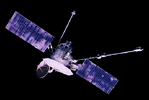
Without the enhancements, Mariner 10 would not have captured any images. This is because taking the images was supposed to happen when the spaceship was in motion. For instance, the digital camera ensured that the ship would capture as many images as possible. Scientists and explores aligned the spaceship to mercury’s orbit and that is how it managed to analyze the movements of this planet.
The radio transmitters were to be used to transmit the findings captured on tape to the experts in NASA’s offices. The expedition did not last for long because the ship ran out of gas, which led to termination of its transmitter’s portal. However, scientists believe that the ship still goes round the sun, but this argument is far from being true because NASA received the last signal in 1975.
NASA officials argue that the devices that are responsible for conveying information from the ship failed due to their exposure to the radiations from the sun. In essence, the mariner was able to cover 40% of mercury because the sunlight struck only one of the planets and thus, when the spaceship flew over it the images covered only one area while the rest of the planet was shadowed.
The need for messenger
Since Mariner 10 did not complete its mission, NASA decided to deploy another spaceship to provide more information on Mercury. The ship was called Messenger (Mercury Surface, Space Environment, Geochemistry and Ranging). Just as its name suggests, the ship was destined for mercury with the aim of analyzing the planet’s environment and the chemical matter on the planet’s surface. Messenger was launched to address the following specific questions about Mercury:
- What was the planetary formational process of Mercury? Was it through volcanism or coverage by particles from craters?
- How can we describe the history of Mercury in regards to geologic concepts?
- What are the state and source of the planet’s magnetic composition?
- What is the nature and size of Mercury’s iron core?
- What are the essential volatile species on Mercury?
- What are the radar-reflective components at the planet’s surface?
Messenger used the same approach like its predecessor, the Mariner 10, Messenger was bound to capture more information regarding mercury due to its advanced mechanisms. Messenger strives to address the questions above because the ship still sends information back to earth. More truth waits to be unveiled through space expeditions because now, Mercury is out of bound due to unfavorable weather conditions.
In this regard, space explorations have advanced our knowledge about the solar system. The solar system is far from complete exploration because newer technologies are still emerging to ensure we are able to get more information regarding Mercury. The flyovers have been very useful because scientists have been able to understand the compositions of other planets during the epic flyovers.
The position of Mercury favors space expeditions because it is very close to the sun, and thus the data obtained from it is essential to reflect the composition at the core of solar system. The space explorations help us to understand why the earth is the only planet that can support life.
Messenger
Messenger’s mission was commissioned in 2004 by NASA. The first departure took place in January 2008. This implies that the probe team needed four years to prepare for the departure to ensure that the occurrence experienced with Mariner 10 does not recur. Nevertheless, during the first departure the spaceship navigated over the skies of mercury and managed to capture numerous images of the planet including the other half that Mariner 10 did not cover.
Test Drive
The second departure happened in October 2008.The ship had earlier been tested in 2005 by NASA who made the ship to navigate the area over the earth’s surface. During this period of test drive NASA was certain that all the equipment were going to function as intended. The ship was able to analyze the compounds in the earth’s atmosphere. Besides that, the tools fitted on the ship were able to gauge the magnitude of the earth’s magnetism. Engineers repeated these tasks once the ship in the Mercury’s orbit.
In October 2006, Messenger navigated the space adjacent to Venus with the aim of acquiring geological knowledge on the planet. However, NASA did not accomplish the mission because the earth was in a position that prevented the sun from emitting radiation, and thus it was difficult to capture the images without natural light.
The explorers had to repeat the fly over session in June 2007 because the first one did not bear any fruits. During this second episode, the tools mounted on the ship were able to capture images on the surface of Venus. This success was because of the sun’s radiation that created ultraviolet rays, thus enhancing the imaging process. The camera captured the images in x-ray format.
Encounter with Mercury
After the first and the second flyovers in 2008 were successful, Messenger decided to make the last navigation in 2009. It is important to note that the aim of each flyover was to capture more information than the previous one and therefore the ship had to fly deeper to get a clear view.
During this last session, the speed of the ship declined and thus it had to proceed in safe mode. This challenge did not hinder it from navigating the space but it eventually led to loss of data captured. However, scientists managed to control the situation seven hours later. The ship had to go deeper into the space, and it was difficult to achieve this objective without altering the velocity of the ship. Engineers executed the DSM-5, which was part of the ship to earn the magnitude of velocity that was necessary to enhance the integration process.
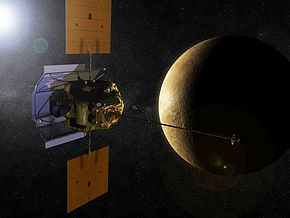
If DMS-5 was not eliminated the ship would not have been able to move faster once it reached the sun’s gravity pond. In addition, the ship would have consumed a lot of fuel to travel at a higher speed. In March 2011, NASA managed to incorporate Messenger at a strategic position in Mercury’s orbit to shield it from the sun’s radiation.
Spaceship Design
The entire structure of the ship measures 1.82 meters, which is its height and a corresponding width of 1.27 meters. The engineers hoist the structure using graphite fiber materials, which ensure that the propellant tanks remain in their place. The graphite panels is made into a compartment that houses the LVA(large velocity adjust) thrust, attitude regulators, rectification thrusters, antennas, instrument pallet and extensive ceramic textile material.
The ship’s luggage capacity cannot exceed 607.8 kilograms. Four 22N monopropellant thrusters direct the ship when the engine executed the10 thrusters at the initial stage. The attitude regulators, through a response wheel attitude-regulator system use the monopropellant thrusters. Attitude regulation is induced by information availed by star trackers in conjunction with inertial system and six sun sensors.
Two small deep space transponders convey information through the deep space network. The DSN is aided by three antennas that transmit signals at different intervals that are high, medium and low. All the three antennas have the capacity to convey 8.4 GHz of signal. On the other hand, they cannot accept signals beyond 7.2 GHz.
The antennas are on the uppermost front such that they are in the sun’s line of view. Another pair of three antennas is on the rear of the ship. This positioning of antennas ensures that they can get signals from the surrounding environment before and after approaching the planet.
The spaceship obtains power from a two panel solar array that generates 450 watts. Each of the panel is movable which means they can rotate as the position of the sun changes. The panels are fitted with reflectors to divert excess solar energy. The solar energy is stored in a 23-ampere nickel hydrogen battery.
Besides, a computerized system operates The Messenger. IBM manufactures the processors of the system and they are highly resistant to radiation. One of the processors is 25 MHz. This capacity is ideal because this processor handles most of the tasks in the system. The other processor is 10 MHz and is responsible for rectifying any errors that may arise during the ship’s expedition.
The ship has recorders that are specialized for capturing still images and has the storage capacity of one gigabyte. The recorders have a processor that keeps the information obtained from the space in compressed formats, which the machine then conveys to NASA offices for interpretation purposes.
This means that if the spaceship downloads information to the wrong target, the data would be irrelevant. The spaceship employs a SciBox application program to induce the functionality of the tools that are responsible for capturing images and radiations. The program ensures that each tool functions independently to avoid a clash of system request. This is similar to interrupt requests allocated to computer devices to ensure that the system understands the device that seeks its attention.
Tools on the Spaceship
The Messenger has many instruments that enhance its performance. They include numerous CCD cameras. Among the cameras, two of them are unique in their specification because they capture images at broad and narrow angles. These cameras have extremely high resolutions because their lenses have 250 pixels and that capability is limited to every 250 meters.

The wide-angle camera captures colored images when need arises. The cameras reside on a raised surface but most times, they are on top of edges of pointed structures. The wide-angle camera is useful because it helps to draw a line between objects that are in a given image. Without the cameras, it would be very difficult to analyze the features of mercury because the spaceship does not stop during the expedition.
Gamma-ray spectrometer (GRS) gauges the gamma rays received from the core of mercury. This device is capable of detecting the presence of certain compounds in the gamma rays. The compounds that are most likely to be contained in gamma rays emitted from the core of a given planet include oxygen, silicon, sulphur, iron, hydrogen, potassium, thorium and uranium.
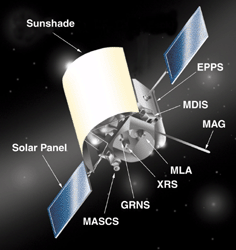
Neutron Spectrometer (NS) analyzes hydrogen compounds in a given mineral matter within a range of forty centimeters. This analysis commences when cosmic rays meet the surface of the mineral. This means that the cosmic rays penetrate forty centimeters into the surface of the mineral. Without this ability, it would be difficult to understand the composition of the minerals because the materials are difficult to extract.
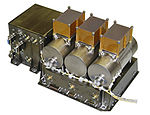
The x-ray spectrometer (XRS) enables one to see the inside of the surface of mercury by identifying the x-ray spectral dimensions originating from magnesium, aluminum, sulphur, calcium, iron and titanium within a range of 1-10 keV. This device uses the same technology as x-ray equipments used in diagnosis of humans. Through x-ray imaging, we are able to understand the core structure of mercury.
The magnetometer (MAG) gauges the magnetic field from the core of a given planet. The same tool determines whether the magnetic field is strong or weak. The earth has a stronger magnetic field than that of mercury: the MAG elicited this information.
The Mercury laser altimeter (MLA) evaluates the heights of tall features on the surface of mercury such as mountains and ridges. Scientists obtain the exact details of land formations when the infrared light lands on the surface of mercury and because while the ship is in motion, it derives the figures when the light is departing from a given area.
Additionally, the mercury atmospheric and surface composition spectrometer (MASCS) analyzes the attributes of mercury’s atmosphere. This knowledge emerges because the machine traps the ultraviolet rays that fall on the surface of mercury when they are being refracted.
The reflectance helps is detecting the presence of titanium and iron on the surface of mercury. Besides that, the charged particle and plasma spectrometer (EPPS) gauges the charged particles that are within mercury’s magnetosphere by employing a charged particle spectrometer to observe the charged particle that is obtained from the surface of mercury during the use of fast imaging plasma spectrometer.
Messenger Data to-Date
The expeditions of Messenger into mercury have inspired other agencies to embark on their own missions. Japan is planning to combine its efforts with Bepicolombo, which is a European agency in a bid to deploy a spaceship to mercury. The two entities have two common agendas, which entail understanding the map of the planet and evaluating the magnetosphere of the same planet.
Bepicolombo is committed to penetrating the orbit of mercury by the year 2019. This is because the agency aims at gaining geological knowledge of planets that are adjacent to mercury in its first years. This is to suggest that they will employ the same tactics of flying over the planet several times.
The approach is ideal because it worked for mariner 10 and Messenger. The Russian Soyuz also expects to deploy their spaceship into the orbit of mercury.
Conclusions
It seems that geological agencies are focusing on understanding the structure of mercury. The space expeditions are significant because they help in eliminating assumptions. For instance, before the deployment of mariner 10 some people used to think mercury is a star while others thought it is a moon of its own kind.
Other agencies should refer to the experience that Mariner 10 encountered to keep their distance from the sun to avoid coming into contact with radiations of the sun. Telescopic observations should also continue because they can also capture events as they unfold. The materials used to construct spaceship should be resistant to radiation such as the ones used on Messenger.
Before deploying a spaceship into the space, engineers should test-drive it to prove that all the tools are functioning as expected. The structure of the spaceship should be flexible to take full advantage of the solar energy as was seen in Messenger. Moreover, engineers must not ignore scientific tools in a spaceship, and that means that a backup plan is required, just in case there is any fault.
References
- “BepiColumbo – Background Science”. European Space Agency.
- “Countdown to MESSENGER’s Closest Approach with Mercury”. Johns Hopkins University Applied Physics Laboratory. 2008. Web.
- “ESA gives go-ahead to build BepiColombo”. European Space Agency. 2007. Web.
- “Gamma-Ray and Neutron Spectrometer (GRNS)“. NASA / National Space Science Data Center. Web.
- “Magnetometer (MAG)“. NASA / National Space Science Data Center. Web.
- “Mercury Dual Imaging System (MDIS)“. NASA / National Space Science Data Center. Web.
- “Mercury Elongation and Distance”. Numbers generated using the Solar System Dynamics Group, Horizons On-Line Ephemeris System. Web.
- “Mercury”. NASA Jet Propulsion Laboratory. Web.
- “MESSENGER Engine Burn Puts Spacecraft on Track for Venus”. Space Ref. Web.
- “MESSENGER Gains Critical Gravity Assist for Mercury Orbital Observations”. MESSENGER Mission News.
- “NASA Spacecraft Circling Mercury”. The New York Times. Web.
- “Space Topics: Compare the Planets: Mercury, Venus, Earth, The Moon, and Mars”. Planetary Society. Web.
- “The Medium-gain Antenna of the MESSENGER Spacecraft”. Microwave Journal. 2005.
- “X-ray Spectrometer (XRS)“. NASA / National Space Science Data Center. Web.
- Bakich, M. E. (2000). The Cambridge Planetary Handbook. New York: Cambridge University Press
- Baumgardner, J., Mendillo, M., & Wilson, J. K. (2000). A Digital High-Definition Imaging System for Spectral Studies of Extended Planetary Atmospheres. I. Initial Results in White Light Showing Features on the Hemisphere of Mercury Unimaged by Mariner 10. The Astronomical Journal, 119 (5): 2458–2464.
- Biswas, S. (2000). Cosmic Perspectives in Space Physics. Astrophysics and Space Science Library. New York: Springer.
- Correia, A.C. & Laskar, J. (2004). Mercury’s capture into the 3/2 spin–orbit resonance as a result of its chaotic dynamics. Nature, 429 (6994): 848–850.
- Dantowitz, R. F., Teare, S. W., & Kozubal, M. J. (2000). Ground-based High-Resolution Imaging of Mercury. Astronomical Journal, 119 (4): 2455–2457.
- Lakdawalla, E (2008). MESSENGER Scientists ‘Astonished’ to Find Water in Mercury’s Thin Atmosphere. The Planetary Society. Web.
- Espenak, F. (2005). Transits of Mercury. NASA/Goddard Space Flight Center. Web.
- Fleming, N. (2008). Star Trek-style ion engine to fuel Mercury craft. The Telegraph
- Grayzeck, E. (2008). Mariner 10. NSSDC Master Catalog. NASA. Web.
- Walker, J. Mercury Chaser’s Calculator. Fourmilab Switzerland. Web.
- Kelley, D. H., Milone, E. F., & Aveni, A.F. (2004). Exploring Ancient Skies: An Encyclopedic Survey of Archaeoastronomy. Birkhäuser.
- L. V. Ksanfomality (2006). Earth-based optical imaging of Mercury. Advances in Space Research, 38 (4): 594.
- Laskar, J.; Gastineau, M. (2009). Existence of collisional trajectories of Mercury, Mars and Venus with the Earth. Nature, 459 (7248): 817–819
- McClintock, W. & Lankton, M. (2007). The Mercury Atmospheric and Surface Composition Spectrometer for the MESSENGER Mission. Space Science Reviews, 131(1): 481–521.
- Moore, P. (2000). The Data Book of Astronomy. New York: CRC Press.
- Roylance, F. (2011). Messenger successfully goes into orbit around Mercury. Baltimore Sun. Web.
- Schaefer, B. E. (2007). The Latitude and Epoch for the Origin of the Astronomical Lore in Mul.Apin. American Astronomical Society Meeting 210, #42.05 (American Astronomical Society) 38, 157
- Srinivasan, D.K., Perry, M.E., Karl, B. F, Smith, D.E., & Maria, T.Z. (2007). The Radio Frequency Subsystem and Radio Science on the MESSENGER Mission. Space Science Reviews, 131(1), 557–571.
- Staff. (2008). MESSENGER: Mercury and Ancient Cultures. NASA JPL. Web.
- Tariq, M. (2004). “MESSENGER to test theory of shrinking Mercury”. USA Today. Web.
- Tunç T. (2003). Total Solar Eclipse of 2006 March 29. Department of Physics at Fizik Bolumu in Turkey. Web.
- Sprague, A. L. Mercury: A World of Fire and Ice. Web.
- “Planet Mercury Data”. Web.

